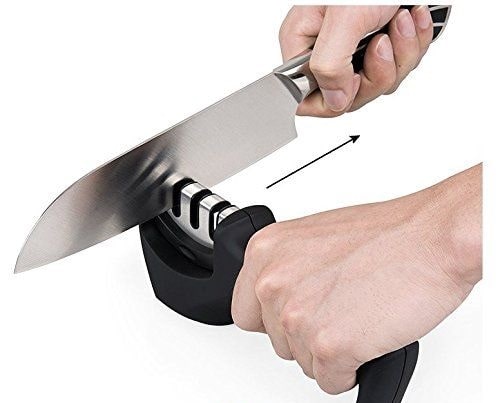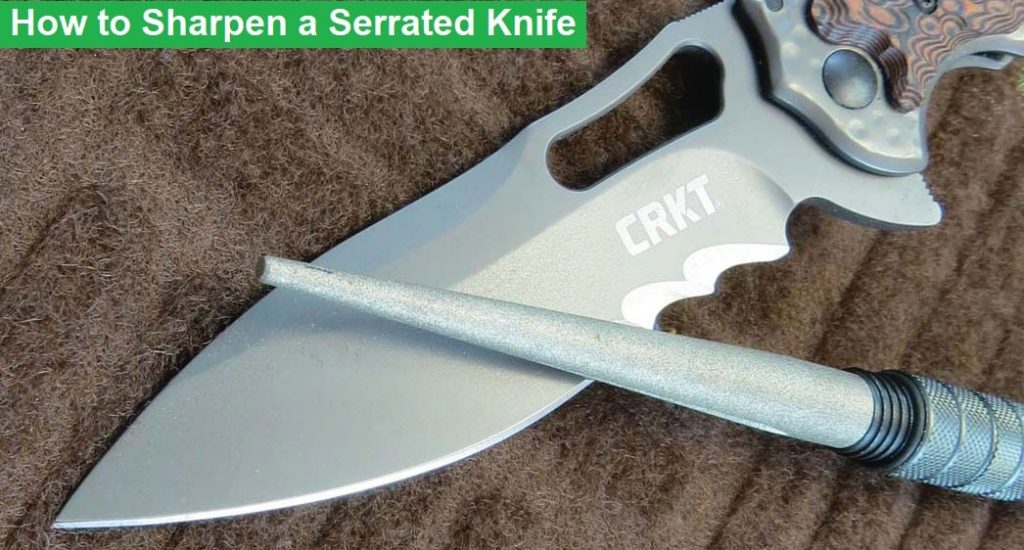The serrated knife is one of the most exciting utensils in our kitchens because it can cut through any ingredient with a clean-cut! It is capable of chopping through soft vegetables or pastries without smashing up their internal soft sections. Due to its unique design, a serrated knife can go for a very long time without requiring sharpening as other knives do. However, eventually, it does require some honing to maintain its effectiveness. How exactly do you sharpen a serrated knife? Moreover, how do you keep it sharp and ready to chop? We’re here to shed light on this activity to boost your culinary satisfaction.
Automatic Sharpening vs. Manual Sharpening, Which is Better?
Automatic Sharpening:-
Advances in technology have resulted in automatic knife sharpening machines that work perfectly for standard, straight edge blades. High-end knife sharpening machines even have a slot for serrated knives. Do they work just as perfectly on serrated knives? Unfortunately, they don’t. The majority of knife sharpeners only touch the tip of the knife’s serrations. In addition to that, they can damage your serrated knife by sharpening both sides of the blade.

Deluxe automatic knife sharpeners go the extra mile and use spring-loaded sharpening bars to conform to the angle and concave of your serrated knife’s gullets. Despite this sophisticated engineering, they still cannot cover the entire surface of these gorges. As such, even high-end automatic sharpeners cannot sharpen a serrated knife correctly.
Manually Sharpening a Serrated Knife:-

To sharpen a serrated knife properly, you’ve got to do it the old school way. This is where you sharpen the knife tooth by tooth. The standard serrated knife has 33 gullets, so you can expect to spend at least an hour to sharpen all of them correctly. This process will require only one tool, a ceramic honing rod. While this rod can be made of steel or even diamond, ceramic is both strong and affordable. This tool is designed such that it fits directly into the gullets of your serrated knife, so it is perfect for the job.
How to sharpen the serrated knife with a ceramic honing rod:-
With the honing rod in hand, begin at the base of your serrated knife. Place it in the serrated grooves that are known as gullets. Position the honing rod at an angle such that it matches the beveled edge of the serrated knife. When the honing rod lies flush with the bevel, you automatically get the correct sharpening angle.
Slide the ceramic honing rod towards the cutting edge of the serrated knife. Apply a small amount of pressure as you slowly slide it. This shall shave some of the stainless steel of the knife and create a sharper edge.
Repeat this process for every gullet while applying a few slides in each one. Sharpen each gullet with patience and deliberate movement. This reshapes the gullets and teeth until their tips are sharp and highly effective. This is very important because the sharp tips make the first contact with any vegetables or pastries that you are cutting up.
After sharpening every gullet, turn the knife over so that its flat side is up. During the sharpening procedure, the ceramic honing rod removes some pieces of stainless steel of the sword. In some cases, these pieces leave jagged remains on the flat side of the blade that is known as burrs. If you rub your finger along the flat edge gently, you’ll feel these burrs. Despite being unsightly, these burrs are evidence that you’re actually sharpening the knife. To complete the honing process, you should remove these burrs.
Run the flat side of the knife along with a fine-grit finishing stone slowly and steadily. The rough surface of the finishing stone will gently and effectively remove the burrs. Once all the burrs are off, you’ve successfully sharpened your serrated knife!
The semi-automatic sharpening machine:-
There is a semi-automatic machine that you can use to restore the sharp edge of your serrated knife with less effort. The machine has a V-shape groove that is 40 degrees wide in which there are strategically angled ceramic rods. Place the knife’s serrated edge in this groove and move it back and forth.
One of the rods will enter the knife’s gullets and sharpen them one by one. With a deliberate hand, sharpen the knife along this ceramic rod until you’re confident of its sharpness. This movement will result in burrs on the flat end of your knife. Thankfully, you can use the other ceramic rod to shave them off. This restores the flatness correctly and ensures that your serrated knife is sharpened correctly with minimal effort.
How does your serrated knife get dull?
Serrated knives are known for retaining their sharp edge for much longer than regular chef’s knives. However, with long enough usage, they will lose their sharpness. How and why does this happen? We found that it has much less to do with your pastries and much more to do with your cutting board.
Whenever you cut a vegetable or some bread with your serrated knife upon a cutting board, its teeth hit the hard surface. The first few times may not have much effect due to the hardness of stainless steel. However, continued usage eventually causes the teeth to bend to either side which is referred to as going out of correct.
By changing direction in this way, the teeth expose the gullets to the impact of the cutting board, causing them to lose their sharpness. When this process is repeated for long enough, it causes the serrated knife to completely lose its sharpness and require an excellent old honing.
Alternatives to sharpening your serrated knife
From our revelation, it is clear that sharpening your serrated knife is a lot more tedious than you though because you may have to spend hours sharpening 33 gullets. If you are desperate for an alternative, there are ways to go around this.
A serrated knife retains its sharp cutting edge for years, but after heavy usage, those sharp V-shaped teeth turn into U-shaped stubs. An easy way to know that your serrated knife has lost its sharpness is when it leaves crumbs on the cutting board instead of cutting clean through your pastries. At this point you have two options If you don’t want to sharpen it manually:
Use its warranty
Some manufacturers can resharpen your serrated knife as part of the warranty agreement. If your knife is still covered, you can send it to the manufacturer or take it to one of their outlets on an excellent resharpening. Best of all, this process will not cost you a penny.
Take it to a professional knife sharpener.
Numerous technicians can sharpen your serrated knife and restore its slicing-edge in minutes. By implementing ceramic honing rods or semi-automatic sharpening machines and years of skill, they can have your serrated knife cutting like new again. The service will attract a small fee, but it is well worth the investment.
Buy a new one
Do you just want to continue cutting without much fuss? Simply buy a new serrated knife. Seeing as it will keep its sharpness for years, purchasing a new one saves you time and proves to be a good investment.
Tips and tricks for keeping your serrated knife sharp
Always wash it by hand.
Did you know that cleaning your serrated knife in the dishwasher dulls its edge? Oh yes, the combination of detergent, heat, and water can cause your serrated knife to lose its sharpness. Instead of throwing it into the dishwasher along with other utensils, wash your serrated knife by hand. This enables you to exercise gentle cleaning strokes along its length. Furthermore, you can pay closer attention to clean the gutters properly and eliminate any errant crumbs effectively. In doing so, you get it clean and retain its sharpness at the same time.
Store your serrated knife properly
This is just as important in retaining its sharp edge as careful cleaning. Store your serrated knife in its own compartment within your drawer. If you throw it haphazardly along with spoons, forks, and other knives, they could scrape along its serrated edge during retrieval and dull it. As such, use a dedicated drawer section for your serrated knife or store it in its own slot within a knife block. This retains its sharpness and keeps you, your children, and pets safe.
Overall
The serrated knife is a chef’s best friend due to its ability to cut through anything with minimal mess or hassle. You can slice through bread or cake with this knife and get a clean, smooth cut. Should it lose sharpness, we’ve shared a collection of solutions that you can use to resharpen it. In addition to that, follow our tips and tricks to keep it sharp over the long term. If well sharpened and maintained, a serrated knife will serve you for years!

